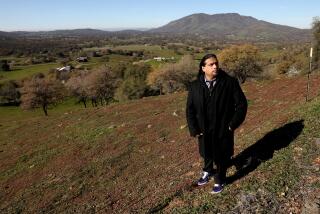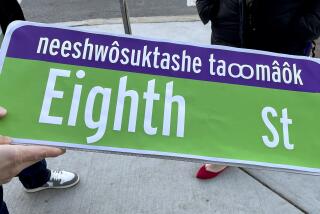All Signs Point to Gaelic as Ireland Stresses Tradition
- Share via
DUBLIN, Ireland — Tourists, beware: Your guidebook may tell you the way to Dingle in County Kerry, but all the road signs will point you toward An Daingean in Contae an Ciarrai instead.
In an age where many people bemoan English’s growing global influence, advocates of local languages scored a small victory last month when Ireland enacted a law outlawing English in road signs and official maps on much of the nation’s western coast, where many people speak Gaelic.
Locals concede the switch will confuse foreigners in an area that depends heavily on tourism, but they say it’s the price of patriotism.
“The change is nice for the locals, but if a stranger’s coming in without one of the new Dingle maps, it can be quite difficult,” said Sarah Brosnan, assistant manager of the Dingle Bay Hotel, which -- like most things connected to the tourist trade -- won’t be changing its name.
In all, more than 2,300 towns, villages, fields and crossroads that traditionally had both English and Gaelic names have had their previously bilingual road signs changed to Irish only. The change chiefly affects three far-flung regions of the western seaboard called the Gaeltacht, which has long been the nation’s last stand in the battle against English dominance.
There, English place names no longer have legal standing and may not be used in government documents or on official Ordnance Survey maps. The switch also applies in a few official Gaelic-speaking pockets of County Meath, northwest of Dublin, and County Waterford in the southeast.
On the breathtakingly beautiful Dingle peninsula in northwest County Kerry, signs with English spellings were removed weeks ago, even in cases where the English versions remain popular in local parlance. Local villages still principally known as Ballydavid, Castlegregory and Ventry are now called only Baile na nGall, Caislean Ghriaire and Ceann Tra.
Gaelic enthusiasts say such place names are redolent of local history and eventually will prove less confusing for visitors -- so long as they are armed with updated or Gaelic-friendly maps.
Locals like Brosnan, who went to an all-Gaelic school but speaks English as her first language, say promoting Gaelic is a point of pride.
“I can’t see them ever allowing English back onto the signs,” she said.
The new law says the government-run Ordnance Survey mapping agency must use only Gaelic names in the Gaeltacht area. The law does not apply to independent producers of maps, although they are expected to follow the policy.
The initiative has placed a new focus on the battle to preserve Gaelic in Ireland, where the language faded from everyday use in the 19th century, when Britain ruled the land.
Ever since Ireland won independence in 1922, successive governments have pursued a policy of mandatory Gaelic in schools and made it a requirement for many jobs, even though just 55,000 native Gaelic speakers remain in this country of 3.9 million.
About 40% of residents identify themselves as fluent in Gaelic on census forms, but in practice that doesn’t seem to be anywhere near the case.
The government’s Irish language commissioner, Sean O Cuirreain, reported that the state was spending $650 million annually on teaching children Gaelic in elementary and high schools, yet too few students were attaining “a reasonable command of the language” after 13 years and 1,500 hours of instruction. He called for an urgent review of how Gaelic is taught.
English, in practice, permeates even government-funded projects to promote Gaelic.
The state-run Gaelic radio network recently decided to begin broadcasting popular music in English, while the state’s Gaelic TV station runs English-language films, often American cowboy movies. Other programs include such distinctly non-Gaelic offerings as “SpongeBob SquarePants.”
O Cuirreain noted that the government and opposition lawmakers, though almost entirely pro-Gaelic in policy, were demonstrably pro-English in practice -- less than 1% of parliamentary debates are conducted in Gaelic.
Another effect of the law is that, for many places, the government has settled eons of argument about what the locality’s real Gaelic name should be. Some villages and smaller rural entities called “townlands” have had rival spellings -- and even competing names.
The town of Mountcharles in northwest County Donegal, for instance, has often been known in its straight Gaelic translation “Moin Searlas,” but the government-approved list rejects this in favor of a more medieval name, “Tamhnach an tSalainn,” pronounced as “townuck awn tallan” and meaning “hill of salt.”
More to Read
Sign up for The Wild
We’ll help you find the best places to hike, bike and run, as well as the perfect silent spots for meditation and yoga.
You may occasionally receive promotional content from the Los Angeles Times.






